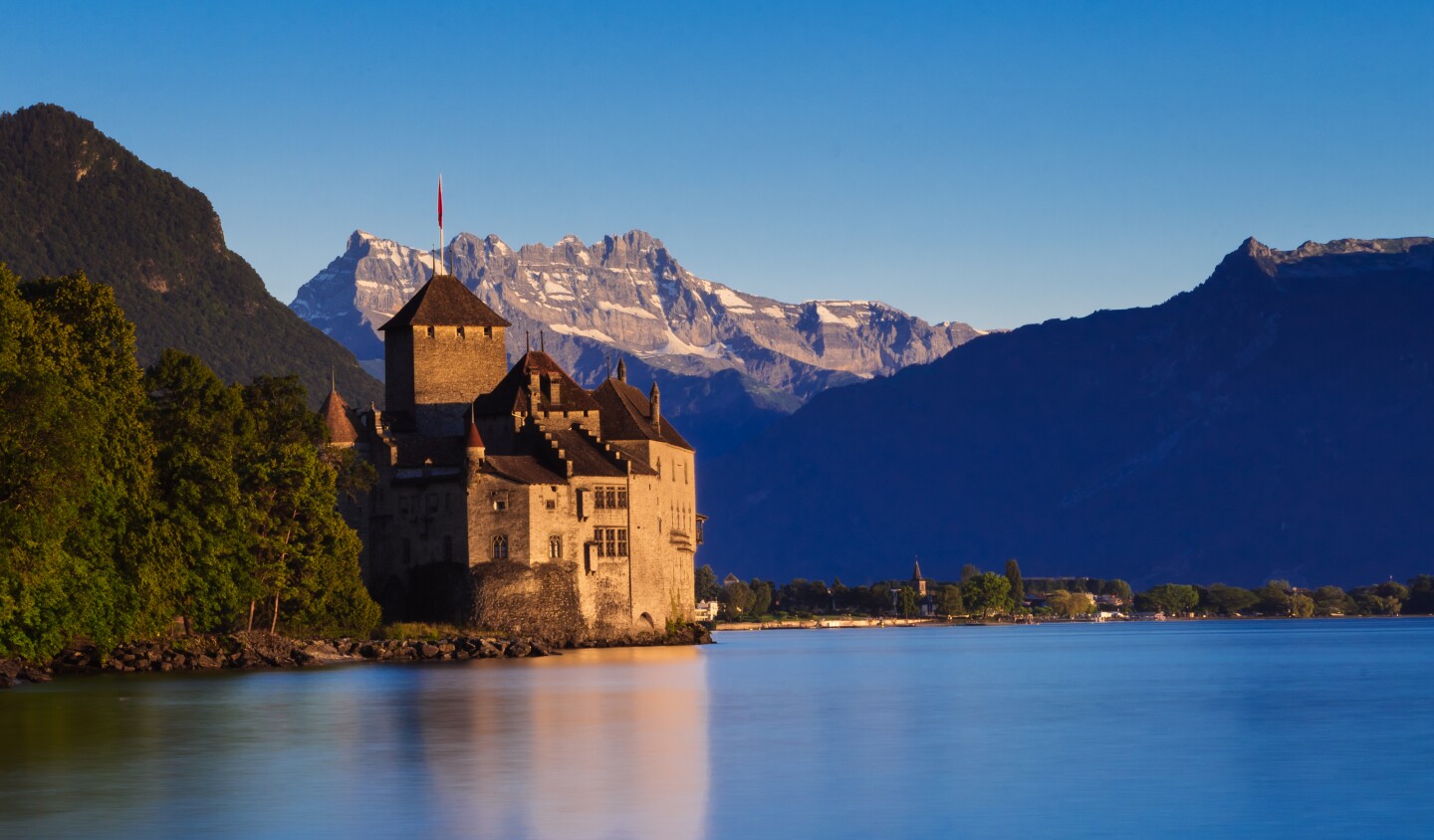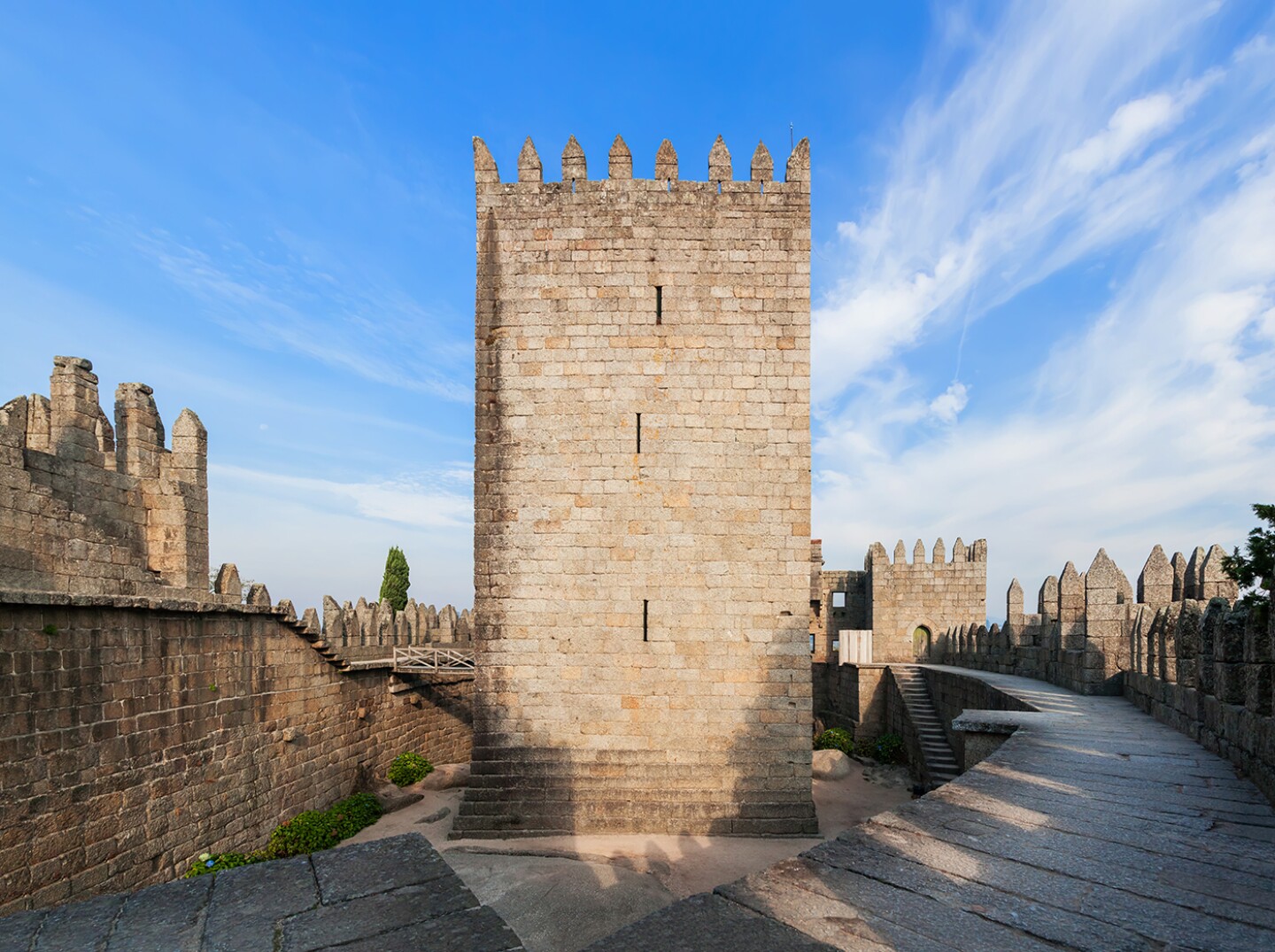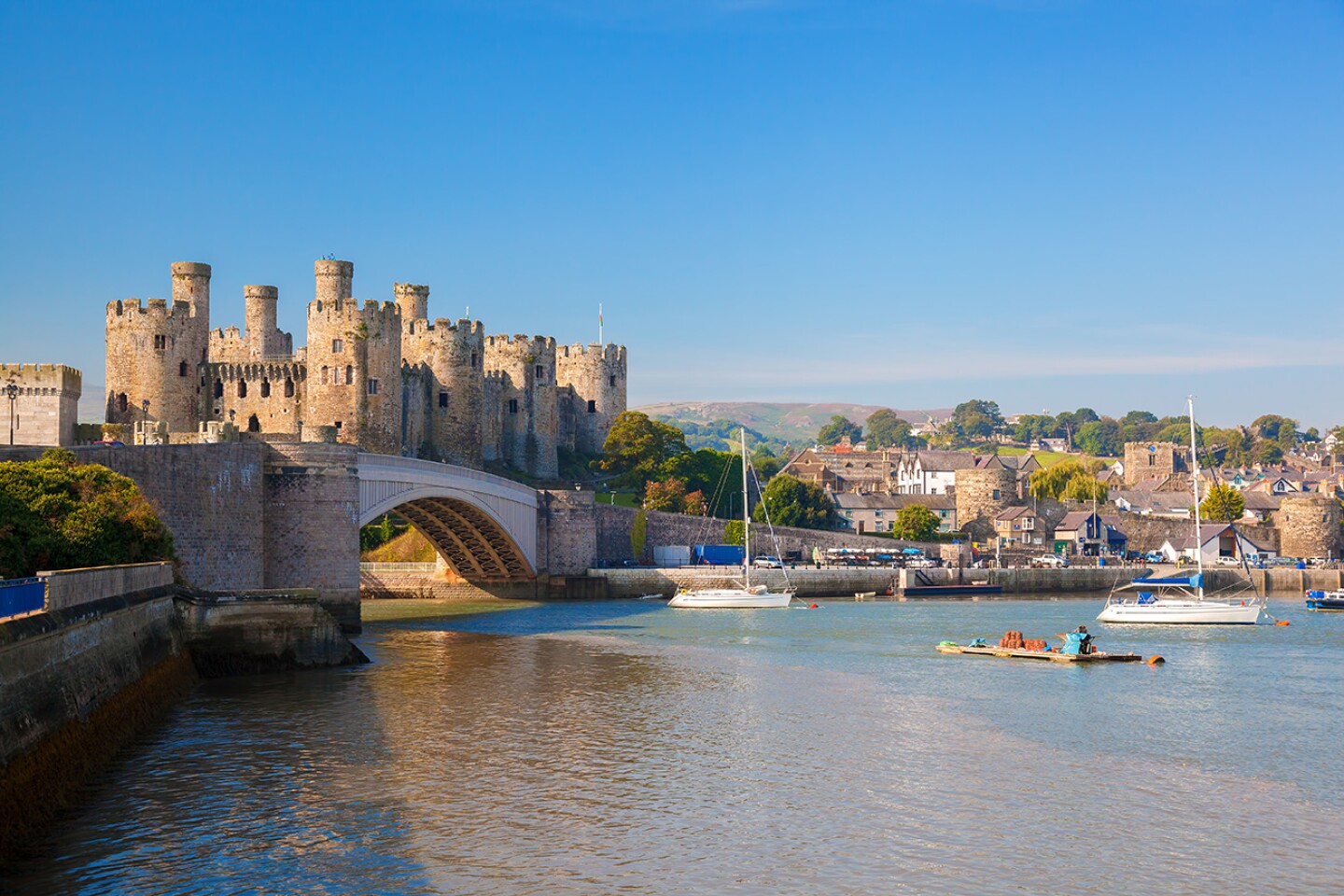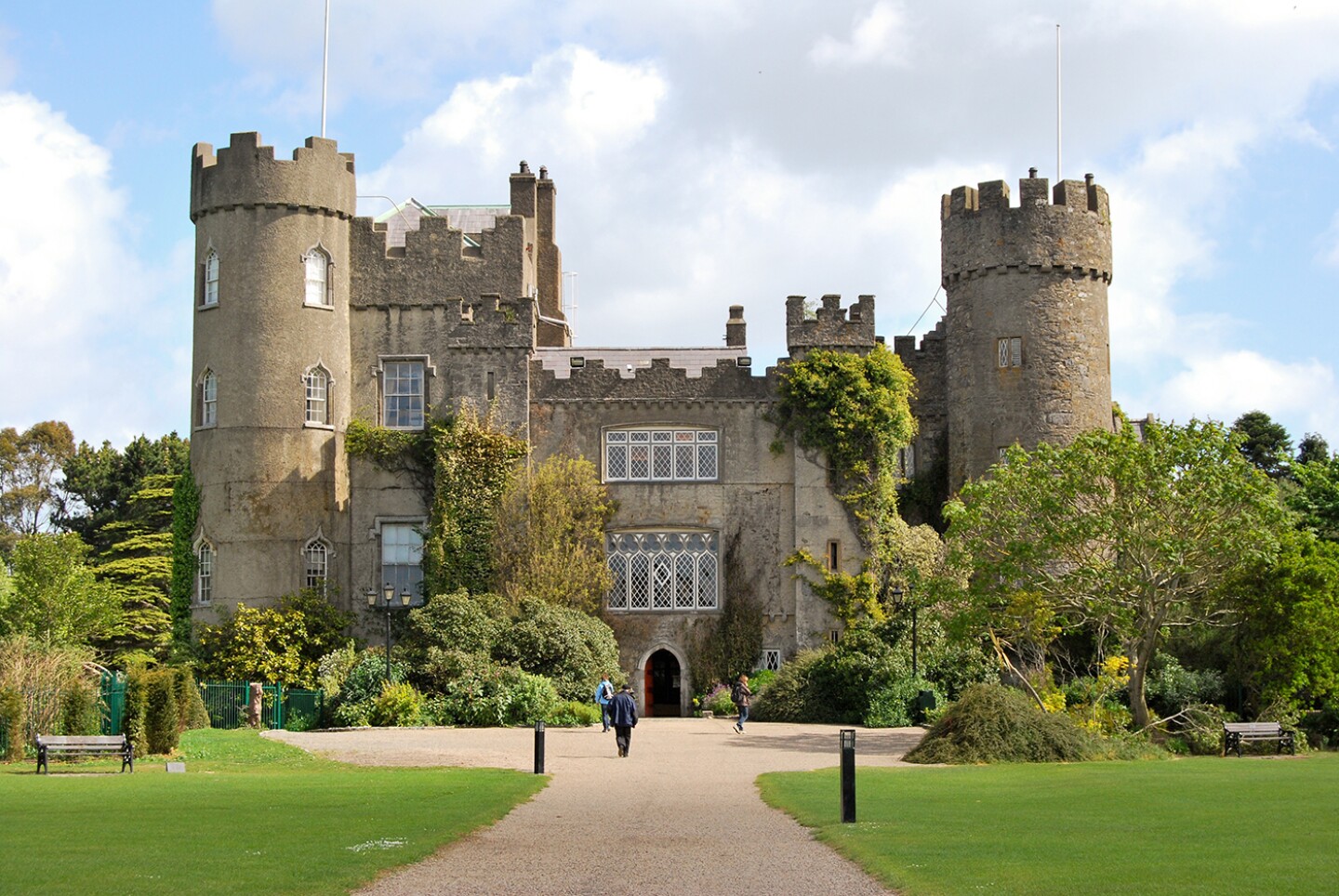Whether it’s seeing a Renaissance sculpture or enjoying street food in Singapore, there’s no substitute for being there when it comes to travel. When your agenda includes visiting medieval castles—from the mighty feudal strongholds of Scotland to Germany’s fairy-tale-like creations—imagination helps to conjure up the smells, draftiness, and lack of central heating. At the least, touring one will leave you grateful for the mod cons of 21st-century indoor life.
An example from Ross Castle in Ireland, which an AFAR editor recently explored: After winding her way up corkscrew staircases, she reached the top floor. It featured the living room or great room of the place. But what captured her attention was down a slim stone hall: The latrine had double-, if not triple-, wide seating. (Alas, photos were not allowed.) That lack of privacy at the privy underscored the communal nature of castle life.
In some countries, you can hardly throw a stone without hitting a castle. Wales has more than 600 castles (the most per square mile). Many European castles are scenic ruins but plenty have survived intact. They were built to last. So while there is no shortage of castles to explore, some are decidedly more intriguing than others. The following 14 castles illustrate the range of architecture on view. They all were started during the medieval era (aka Middle Ages), which is about 500 to 1450 C.E. Here’s how to visit 14 of most impressive medieval castles in Europe and the United Kingdom.

Bellver Castle in Spain is a rare circular fortress
Photo by Shutterstock
1. Bellver Castle
Palma de Mallorca, Spain
Bellver Castle is a 14th-century Gothic-style castle on a hill overlooking Palma de Mallorca. Built between 1300 and 1311, on the order of King James II of Mallorca, it is a rare circular castle, with a round courtyard in the middle. The moat was added later. Its elegant two-story interior of arches topped by a colonnade indicates that it was a royal residence, not simply a fortress. But by the early 18th century it became a military prison. The City History Museum, on the ground floor, helps put the building in context.
How to visit Bellver Castle
About two miles west of the center of Palma, the castle sits atop a hill, giving you a 360-degree view of the city and bay of Palma. You can drive to it on Camilo José Cela Road or take a local bus. It is open to visitors year round, Tuesday through Sunday. Free guided tours in English are available Tuesday to Saturday.

The scenery is just as grand as the castle itself at Château de Chillon.
Photo by Shutterstock
2. Château de Chillon
Veytaux, Switzerland
Not simply the most popular castle in Switzerland, Château de Chillon is also the most-visited historic building in the country. Part of that appeal is its location: on an island in Lake Geneva, which acts as a natural moat. Like many castles, additions and occupation continued after the Middle Ages, but the castle got its start in the mid-13th century. Gothic vaults from that time are visible in the prison.
And part of the appeal of this castle is its association with Lord Byron. A visit there in 1816 inspired him to write the epic poem “The Prisoner of Chillon.” It’s based on the story of Francois Bonivard, a political prisoner.
How to visit Château de Chillon
Public transport options to the Chillon include a 75-minute train ride from Geneva three times a day and a direct ferry from Lausanne in the morning that takes 90 minutes. By car, the castle is about 2.5 miles from Montreux, and it’s open year round, except for the last week of December. Among several options for guided tours, you can finish with a glass of Clos de Chillon wine.

Don’t forget to explore the gardens as well while at Muiderslot.
Photo by Shutterstock
3. Muiderslot (Muiden Castle)
Muiden, The Netherlands
Located nine miles southeast of Amsterdam, the formidable 13th-century castle of Muiderslot looms over the mouth of the Vecht River, where its fantastical round towers, dungeon, armory, and knights’ hall can be explored independently (with the help of an English-language audio guide or downloadable app). It’s especially entertaining for kids, who can dress up like knights, practice jousting, and, from April through October, watch a falconry display.
How to visit Muiderslot
Public buses operate from Amsterdam to Muiden, though you’ll have to change at several points. If you’re visiting from April through October, hop the daily ferry from Amsterdam’s IJburg marina and sail to the castle via IJmeer, a lake. Or rent a bike: An easy, scenic, signposted bike route to the castle from the city takes about 45 minutes.

Conveniently located on Scotland’s main tourist route to the Isle of Skye, the dramatic setting of Eilean Donan Castle offers sweeping views of the lochs, the nearby Isle of Skye, and surrounding Kintail Mountains.
Photo by Peek Creative Collection/Shutterstock
4. Eilean Donan Castle
Dornie, Scotland
Fans of Highlander or James Bond’s The World Is Not Enough will likely recognize this picturesque Scottish Highlands castle, set on a small islet encircled by three sea lochs and accessible only by a stone footbridge. First built in the 13th century, Eilean Donan Castle served variously as a fortress, residence, and garrison during its long history before being almost entirely destroyed during the Jacobite rising of 1719. It lay in ruins for nearly 200 years until 1911, when a decades-long reconstruction began. Today, the castle, which you can visit with an audio guide, is largely a re-creation of what it looked like in the 18th century, complete with rich Jacobite-era decor, weapons, and artifacts.
How to visit Eilean Donan Castle
Note that Eilean Donan is closed in January. From Inverness, about two hours away, day tours and public buses offer direct access to the castle.

In the Carpathian Mountains of Romania’s rural Transylvania, Bran Castle is perhaps better known as “Dracula’s Castle.”
Photo by Jenna Brooks/Shutterstock
5. Bran Castle
Bran, Romania
Often referred to as “Dracula’s Castle,” this 57-room medieval fortress is said to be the inspiration for Bram Stoker’s mythical count, based on the ruthless, real-life, 15th-century ruler Vlad the Impaler. Although it’s unlikely that Vlad ever visited Bran Castle, it’s easy to see how the legend stuck, especially during the atmospheric annual, late-night Halloween party. Perched on a steep cliff deep in the Carpathian Mountains of rural Transylvania, the striking red-turreted castle is awash with Gothic details; on an audio-guided tour, seek out the hidden winding staircases, underground passages, and chambers packed with medieval weapons and armor. But it was also home to Queen Marie of Romania from 1920 to 1938; she modernized the 14th-century castle, adding an elevator, and created a sprawling English garden replete with a teahouse.
How to visit Bran Castle
A bus from the city of Brasov, 18 miles away, runs regularly during the high season; Brasov is about three hours by train from Bucharest.

This fairy-tale castle is filled with treasure. Just one example: In the magnificent wood-timbered 14th-century lower hall hangs Madonna With Child and Grapes, a masterpiece by Lucas Cranach the Elder.
Photo by Sergey Novikov/Shutterstock
6. Burg Eltz (Eltz Castle)
Wierschem, Germany
Owned by the same family since it was built nearly 900 years ago, the beautifully preserved Burg Eltz—with eight soaring turreted towers, oriel windows, gables, and half-timber frames—looks straight out of a fairy tale. It juts out from a 230-foot-tall rock, surrounded by forest, deep in an isolated side valley of the Moselle River. A required 40-minute guided tour, in English, leads you through period rooms decorated with original 15th-century murals, tapestries, and furnishings, and vaulted halls lined with medieval armor and weaponry. The treasury, filled with gold and silver historical artifacts, can be visited independently.
How to visit Burg Eltz
Burg Eltz is open from April to November. A seasonal Burgenbus (castle bus) departs from several area train stations on weekends and holidays; the closest is Hatzenport, about a 20-minute ride. Hatzenport is less than 90 minutes by train from Cologne (with a change of trains in Koblenz). There are also multiple hikes to the castle from nearby towns; the most popular is from Moselkern (under 2.5 hours by train from Cologne), a moderately challenging 45-minute climb.

Perhaps best of all at Château de Beynac is the climb up to the battlements, where you can soak up panoramic views of the snaking Dordogne and green fields.
Photo by Shutterstock
7. Château de Beynac
Beynac-et-Cazenac, France
This 12th-century fortress may not rank among the prettiest of France’s many castles, but its towering position, atop a sheer, 500-foot limestone cliff above the Dordogne River, certainly stands out. (Don’t miss the views from atop the battlements.) A double crenellated wall and twin moat protected Château de Beynac during the 100 Years War, and it’s one of the best-preserved in southwest France’s Dordogne Valley. Pick up the audio tour and wander the austere, sparsely furnished rooms of the fortification, including the ancient keep, 13th-century kitchens, and the oratory, lined with 15th-century frescoes. Later rooms date from the 17th century and are decorated with ornate tapestries from the period.
How to visit Château de Beynac
You’ll need a car to get to Château de Beynac; there’s parking next to the castle or it’s a 15-minute walk up from the pretty village of Beynac-et-Cazenac, about a 2.5-hour drive east from Bordeaux.

At Castle of Guimarães, stroll the enormous ramparts and climb the narrow steps to the top of the central tower for eye-popping views of the Ducal Palace and the city below.
Photo by Shutterstock
8. Castle of Guimarães
Guimarães, Portugal
If you want to see where Portugal began, head to the Castle of Guimarães, the birthplace of the nation’s first king, Afonso Henriques, in 1109. It’s perched on a hill above the northern Portuguese city of Guimarães, the country’s first capital. Over hundreds of years, the blocky crenellated towers of the mighty Romanesque fortress defended the nation against Moorish, Norse, and Spanish invaders. In the 16th century, it fell into disuse and was used primarily as a prison; it was classified as a national monument in 1881 and later restored. There’s not much left inside the walls, but the nominal entrance fee gets you access to the ramparts and the central keep’s permanent exhibition about the history of Guimarães and its castle.
How to visit Castle of Guimarães
It’s about a 10-minute stroll up to the castle from Guimarães, which can be reached in about 1.5 hours by train from Porto. There’s also a car park directly behind the castle.

This massive castle complex in South Bohemia is one of the largest in Europe.
Photo by Bernard Barroso/Shutterstock
9. Český Krumlov Castle
Český Krumlov, Czech Republic
For this epic castle, set on a promontory high above the Vltava River in South Bohemia, you’ll want to wear your walking shoes: It’s about a 15-minute uphill walk from the town of Český Krumlov and there are some 40 palaces and buildings, 5 palace courtyards, and a 17-acre park to explore. The UNESCO World Heritage site dates from the 13th to the 18th centuries and features a mishmash of Gothic, Renaissance, and baroque architectural styles.
There are two main guided tours to the interiors (required for access): One concentrates on the original castle interiors from the Renaissance and baroque periods and includes the ornate rococo Chapel of St. George; the second focuses on the history of the noble Schwarzenberg family, former owners of the castle. Highlights include the intricately painted, six-story belfry—climb its 162 steps for panoramic views—and for kids, the bear moat, an enclosure home to a family of four playful bears. Access to the gardens and the bear moat is free.
How to visit Český Krumlov Castle
Český Krumlov Castle is open from April to October. Located near the Austrian border, Český Krumlov is a three-hour bus ride from Prague; from the town, the castle is accessible by foot, taxi, or car.

Dating to the 13th century, the Conwy Castle in Wales overlooks two rivers, the walled town of Conwy’s harbor, and the surrounding mountains of Snowdonia.
Photo by Shutterstock
10. Conwy Castle
Conwy, Wales
Gazing at this vast, imposing stone fortress—one of four Welsh strongholds that Edward I of England constructed during his conquest of Wales—it’s hard to believe that it was built in just four years, between 1283 and 1287. With eight massive round towers, Conwy Castle sits on a promontory above the walled town of Conwy in North Wales, strategically overlooking two rivers and the harbor. Much of the interior is roofless, but the medieval royal apartments, which include the king’s chamber and a small chapel, are well-preserved. No tours are offered, but signage posted throughout provides historical information. Clamber around the battlements and climb the spiral staircases to the top of the towers for impressive views of the surrounding mountains of Snowdonia.
How to visit Conwy Castle
The castle can be reached along the 870-mile-long Wales Coast Path walking trail; for the less intrepid, the closest major city is Liverpool, less than two hours by train or car. The castle is about a half-mile from the Conwy train station or there is on-site parking.

Rochester Castle captured the imagination of Charles Dickens, who described it in The Pickwick Papers as a “glorious pile—frowning walls—tottering arches—dark nooks—crumbling staircases.”
Photo by Shutterstock
11. Rochester Castle
Rochester, England
The 12th-century Rochester Castle, located in the county of Kent in southeast England, is very much in ruins, having withstood multiple sieges during its long history. Though the original 113-foot-high keep still stands, the rest of its vast interior is roofless. Pick up an audio tour for context, then roam atop the ancient battlements, which offer lovely views of the cobbled streets of Rochester and the Medway River below; parts of the crenellated curtain wall surrounding the castle date back to the late 11th century.
How to visit Rochester Castle
It’s a speedy 40-minute train ride to Rochester from London’s St. Pancras station, and the castle is a 10-minute walk from there.

Poland’s Malbork Castle is considered the largest brick fortress in the world.
Photo by Sorin Vidis/Shutterstock
12. Malbork Castle
Malbork, Poland
Also known by a much longer name—The Castle of the Teutonic Order in Malbork—this is the largest brick fortress complex in the world, sprawling across 52 acres along the banks of the Nogat River in northern Poland. (Catch the highlights with an audio guide or, in the summer months, English-language guided tours.) Construction began in 1309, with a high castle and chapel fortified by moats and several defensive walls. In the 14th century, a low castle was added, along with several outbuildings.
The entire complex was virtually destroyed during heavy fighting in World War II; painstakingly rebuilt to its former glory, it’s now a museum and UNESCO World Heritage site. The castle’s collections of amber, original 14th- and 15th-century furnishings, and medieval tombstones are nearly as splendid as its architectural details: towering arched ceilings, colorful frescoes, intricate tile work, and stained glass.
How to visit Malbork Castle
Malbork is a 30-minute train ride from Gdansk or around 2.5 hours from Warsaw; from the station, it’s about a 15-minute walk (or quicker taxi ride) to the castle.

Outside of Dublin, Malahide Castle offers a storybook setting on 260 acres of parkland.
Photo by Neuartelena/Shutterstock
13. Malahide Castle
Malahide, Ireland
Malahide Castle on the outskirts of Dublin was in the same family, the Talbots, for nearly 800 years. (It’s now owned by a local tourism company.) Initial construction began in the 12th century with many expansions throughout its history—including a seamless addition of two towers in 1765; the three-story main tower is original. Inside, the richly appointed rooms are decorated in a range of period styles; most impressive is the Gothic Great Hall, featuring soaring vaulted ceilings and walls lined with stern-faced portraits of Talbot descendants. The storybook setting, on 260 acres of parkland, features 5,000 plant varieties and a butterfly house. Guided tours of the castle (required for entry) take place daily.
How to visit Malahide Castle
The castle is a 25-minute drive from Dublin’s city center (there are also train and bus connections) or 10 minutes from Dublin airport.

Dating to 1077, this Austrian castle overlooks the Salzach Valley and is surrounded by the Tennen Mountains.
Photo by Nalina Schwarz/Shutterstock
14. Burg Hohenwerfen (Hohenwerfen Castle)
Werfen, Austria
A popular day trip from nearby Salzburg, the 11th-century stone fortress of Burg Hohenwerfen ticks all the boxes when it comes to medieval grandeur. There’s the dramatic setting, 500 feet up on a rocky perch (a funicular will save you the climb) overlooking the Salzach Valley and surrounded by towering peaks of the Tennen mountain range. The castle, dating from 1077 (though it’s seen additions throughout the centuries), also looks the part, with multiple towers, magnificent wood-beamed state rooms, a grand frescoed knights’ hall, a hidden stone staircase, an arsenal, a dungeon, and even a torture chamber. Self-guided audio tours are available, and there’s one tailored to kids. The castle is also home to the State Falconry Center, with daily demonstrations of Indigenous birds of prey.
How to visit Burg Hohenwerfen
The castle is open from April to November. There are direct trains from Salzburg to Werfen (lasting about 45 minutes); it’s a 20-minute walk to the castle’s funicular from the station. If you are driving from Salzburg, 25 miles away, there is an on-site parking lot, although note that it’s about a one-mile walk to the castle from there.
This article was originally published in 2019 and most recently updated on October 16, 2023 with current information.











